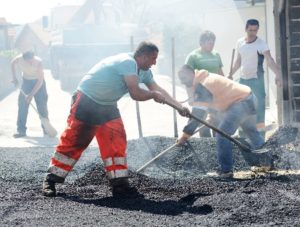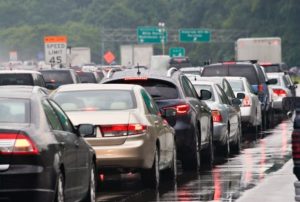 The “information superhighway” was a term coined in the early days of digital communications, perhaps at the onset of the internet, or maybe before, with the arrival of cable television. It may sound “old” already, but looking back, it’s tough to argue the foresight of the one who coined the term “information superhighway.” Let’s open the “time capsule” for a short-term sneak peek at how well the label matched up with the parallels of roads and climbing vehicle traffic, versus bandwidth and building website traffic.
The “information superhighway” was a term coined in the early days of digital communications, perhaps at the onset of the internet, or maybe before, with the arrival of cable television. It may sound “old” already, but looking back, it’s tough to argue the foresight of the one who coined the term “information superhighway.” Let’s open the “time capsule” for a short-term sneak peek at how well the label matched up with the parallels of roads and climbing vehicle traffic, versus bandwidth and building website traffic.
 It was summer of the year 1996. The most favorite new spot in my apartment, a modest corner desk in my bedroom, was hosting its nightly performance. A tantalizing series of beeps, tones and screeches would build suspense, leading toward the desired yet uncertain opening of the curtain. The sudden sound transformation into a blur of white noise confirmed the show would indeed go on. It sounded like the roar of a crowd giving a standing ovation at a symphony. I had a front row seat, and like every night, no idea what I was about to experience.
It was summer of the year 1996. The most favorite new spot in my apartment, a modest corner desk in my bedroom, was hosting its nightly performance. A tantalizing series of beeps, tones and screeches would build suspense, leading toward the desired yet uncertain opening of the curtain. The sudden sound transformation into a blur of white noise confirmed the show would indeed go on. It sounded like the roar of a crowd giving a standing ovation at a symphony. I had a front row seat, and like every night, no idea what I was about to experience.
Settling in front of my Mac Performa 6100CD, the din of its external 14.4k Teleport modem suddenly going silent, the audience sat in silence as I awaited the satisfying salute.
Welcome. You’ve got mail!
The wonders of the World Wide Web awaited. Where would it take me today?
In the world of traditional infrastructure, consideration of capacity is a top-level subject. Whether it is carrying capacity of roads or bridges, flow capacity of sewer lines, or load capacity of power lines, the question is, “How much can be achieved, transferred or supported?” Despite visual evidence that appears in disagreement, it is safe to say the planners of our infrastructure did take capacity into consideration. Our highways may be overcrowded today; but, imagine if they were still the same as in 1940!
While in the seat of an automobile headed through any major city during rush hour, the pace and volume of traffic can be maddening to say the least. What are the causes, disadvantages, and even advantages of this? Under the lens of our internet-parallel microscope, do the answers bear any similarities to one another?
 Let’s look at those roadways first. What are some of the causes of crawling traffic through metropolitan areas?
Let’s look at those roadways first. What are some of the causes of crawling traffic through metropolitan areas?
- Road construction
- Destination popularity (i.e., Disney)
- Mass-navigation prioritization (word of mouth, GPS)
- Motor vehicle crashes or other “must-see” occurrences not related to safe driving
- Commercial, industrial, and residential overdevelopment
- Confusing interchange signage
- Poorly designed off/on-ramps
 Without overstimulating your imagination to the point of creating anxiety and drops of perspiration to form on your forehead, consider the disadvantages these examples may cause on a highway.
Without overstimulating your imagination to the point of creating anxiety and drops of perspiration to form on your forehead, consider the disadvantages these examples may cause on a highway.
- Arrival delays
- Getting lost on detours
- Reckless, last-second decisions at the wheel
- Tire damaging road debris
- Impatient passengers and driver
- Rubbernecking that causes more traffic
- More car accidents from rubbernecking
- Smog
- Roadrage
- Distracted driving from low-speed complacency
The list is far from complete, but it easily supports the case that heavy traffic, especially traffic that grows during peak drive times, can cause numerous problems.
Could we even entertain the possibility that a single advantage is gained by heavy, stop and go road traffic? Call me severely sheltered—where I live, cows outnumber taxis 500 to 1—but I believe there is more than just one good benefit to growing traffic on roads. In fact, slowed traffic delivers a much different driver experience than when hurtling down the highway at 82mph.
First, as noted above, the journey takes longer. In this expanded travel time, one is likely to:
- hear more radio advertisements
- see more billboards
- use more fuel
- get hungrier after seeing so many restaurant signs
- use their cell phone longer
- have more low speed collisions/fender benders
- have more cause to seek stress therapy or the services of a physician
Now it is clear the “advantages” in this list are not primarily those reaped by the driver. However, concede, if you will, the preceding examples are of benefit to someone:
- Advertising sales reps may get to keep their jobs for another month.
- Certainly, gas stations that are planted at the end of every exit ramp will sell another 2.4 cups of coffee and 9.7 overcooked hot dogs for every 500 gallons of gas pumped.
- Countless teenaged burger-slingers will have money to add to their sneaker accounts.
- The shareholders of Verizon and AT&T will still demand higher returns, but the company will retain a majority of market share because not one person would risk being in a traffic jam without good cell service.
- Your local body shop guy will make a few bucks, and your car insurance underwriter gets to raise your premiums faster than you can say “Morgan Law.”
- Your doctor or therapist can make their lease payment on the Benz.
A somewhat serious point: A driver visit to a doctor could also benefit the driver if it uncovers a more serious existing condition.
By Comparison: Building Website Traffic
Looking at the “Information Superhighway” for the causes, disadvantages, and benefits of building website traffic is a more familiar task for some of us. After all, in the digital marketing world, we spend much energy trying to understand and practice this every day. If our website is properly designed and technically sound, we can “cause” website traffic growth by maximizing:
- SEO (Search Engine Optimization)
- PPC (Pay Per Click advertising)
- social media presence
- good content including blogs (optimizing good website page content)
- referrals (developing a good variety of authoritative backlinks)
Building website traffic that is “excessive” is not frequently a cause for regret; but for the sake of comparison, let’s not just consider capacity, but also “user experience.” Browsers today expect a fast, trustworthy, and well-displayed website that rewards their time spent on it with useful information, concise product purchase funnels, and at least a good reason to eventually return. A lack of effort or thoroughness on behalf of the webmaster here is like closing 12 out of 14 booths at the parking lot entrance to Disney World during Easter break.
It was far more frustrating than a baseball rain-delay or driving beyond the range of your favorite FM radio station’s signal. The suddenness of the interruption was a guillotine slicing through your personal “escape time,” and there was no certainty you would resume that experience before needing to shut it down and climb into bed. What was causing these crashes? Was everyone getting the same message on their screen? Had AOL created too much business, new accounts from the endless onslaught of “Free Trial” CDs finding their way into every mode of delivery dreamed of by humankind?
It was a frustrating time, but just a period of growth and progress, no doubt. A small price to pay for the chance to be a pioneer in this revolutionary technology.
A miscalculation or inability to properly adapt to website traffic volume may result in “browser disappointment” (think, “angry driver”), a result of conditions that may include:
- insufficient capacity for sudden browsing volume spikes
- poor website design
- poor website navigation menus
- server/host crash
- poorly timed server/site updates
- broken internal links
- website virus or hacks
- under optimized site performance/page load times
 However, when properly planned, a well-executed website traffic building plan will reward the site owner appropriately with the desired benefits, which include:
However, when properly planned, a well-executed website traffic building plan will reward the site owner appropriately with the desired benefits, which include:
- increased revenue
- increased exposure
- improved reputation
- higher volume of repeat business
Those are the fruits, the destinations toward which we travel on the highway we control. Endless miles of wide lanes paved with smooth, pothole-free surfaces and well-marked lanes. The traffic is heavy but flowing with ease and confidence. Each off-ramp and exit are identified clearly with consistent authority, conveying trust that enhances the quality of the journey.
We know where we are going today when we are well-prepared. As with all technologies, progress can alter the course. A question for a future time capsule examination, if you will permit the road-internet metaphor to continue: How will automated driving technology parallel internet browsing or impact methods of building website traffic into the future?
Jay Wiencko is an SEO Coordinator for That! Company, a Florida-based internet marketing and white label service provider.






























